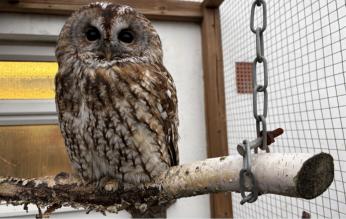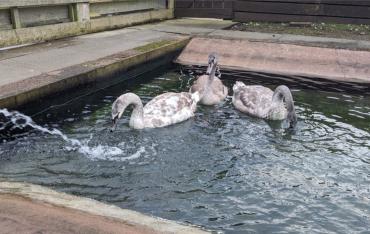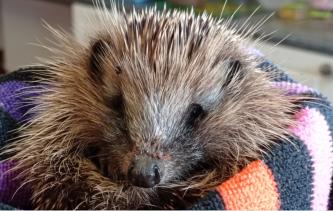
Latest News
Avian Influenza (Bird Flu) Sadly bird flu is now moving on from sea birds, to other species of birds, including geese, ducks and swans,
and the Trust is receiving many calls from the public spotting sick birds. There is no treatment available and sick birds will often die
within a day of showing symptoms. We cannot rescue or accept sick birds at the Centre as this would compromise those birds already in
our care and could lead to the Centre being forced to shut down.
Our advice, painful as it is to give, is to leave the bird and let nature take its course. Do not touch a dead bird or let a dog near it. The
local Council is responsible for collecting them in a controlled manner. In some cases you may report findings to DEFRA on 03459 335577
or visit their web site for detailed advice here.
***************************
Christmas Holiday Period
We shall be closed from 24th December until 5th January 2026.
There will be staff on the premises at various times for feeding and cleaning.
Please leave a message on our answer phone giving your name and number
on 01289 302882 and we will pick up your message.
***************************
"Swan Notes" News items written by Trust members and volunteers and usually appearing in the “Berwick Advertiser" newspaper each
week. For those unable to read these items, and those living outside the Berwick area, here are the last few editions...
24th December 2025
Hello everyone, I am one of the hedgehogs in the Big Room. I am quite happy staying at the Rollo Centre this winter. I am here in the
cooler room so that I can hibernate if I want to but they give us such delicious food- I can’t resist it. It was very cold a couple of weeks
ago and I did stay in bed then for three nights. It was so cold and I had some lovely straw to roll up in. I rolled over and over in the
straw until it made a sort of duvet round me. I was so cosy. Then they gave me some tasty food and the evening was a bit warmer and
the smell! I couldn’t resist it and got up to have a good dinner.
I wasn’t always in the Big Room. When I first came in I was very tiny and the
ground was so hard, I could not find enough food to eat and my mum said I must
look after myself. I know I should only go out at night but I was hungry, so tried
to hunt for a nice beetle in the day time. A kind person picked me up and brought
to the Rollo Centre. I was looked at under a bright light and I heard disapproving
voices say that I had TICKS. I don’t know what they are but they turned me
upside down and poked coloured plastic picks at me and took off a lot of lumpy
things I had on my skin. I thought they were part of me, but, apparently not,
they were TICKS. I did feel better after that, but I had to have needles stuck in
me every day. This was to help me get better, antibiotics I think. Kay said she
was sorry every time she stuck a needle in but it didn’t stop her doing it. Soon I
felt much better, and the food they gave me was delicious so I began to put on
weight.
I had a heat pad to keep me warm as I was only 300 grams. I had lovely food
with a nice sprinkle of calciworms on the top. There were lots of other hogs in the
room and at night it was quite noisy, with hogs eating and making their beds.
There was a very nosy Tawny Owl called Errol, who used to look through the window at us at night. His aviary was over the window of
the recovery room. He did not approve of us Hedgehogs. I just think he is jealous of the all the time the volunteers spend with us. He is
a very superior animal but I think its just because he has been here for so long. Well over ten years he tells me. He has his own set of
rooms specially built for him he says. We (us hedgehogs) pull faces at him though the window.
Now I am just hoping to have a little time in the Hogwards Shed to hibernate and then I can go back to the big outdoors. I shall be
bigger then and be able to find my own food easily. As we have straw beds the volunteers do not have to give us clean beds every day.
They clean our living rooms and give us fresh food and water but don’t make us get out of bed every day, so we can get nice long sleeps.
Actually, I’m feeling quite sleepy now.
Everyone at the Rollo Centre wishes a Very Merry Christmas and a Happy New Year to everyone who has helped through 2025.
A hedgehog
18th December 2025
Firstly I must thank Gill, who has been doing the Jottings for me while I was away. It was lovely not to have to rush out three weeks
before I went.
Jackie and Mandy had decided to have a table top sale at the Rollo Centre last Saturday. It meant a lot of hard work for them to move
everything round, out of the way and set up tables but it looked beautiful when I called in, at about 10.30am, to find that although not
due to open until midday, they were already busy. By two thirty they had raised £393.00. Well done Jackie and Mandy and thank you
both.
As I have been away for three weeks I have had to catch up with what is
going on at the Centre. All the birds of prey have been released except for
one Barn Owl and he is growing in his new feathers very nicely now so we
shall have to monitor his flying skills to make sure he is fully fit, before we
think of release. We shall have to wait for a spell of dry weather, which
seems very unlikely at the moment.
Two Wood Pigeons were brought in as small nestlings. I hand reared them at
home, and now they are doing very well in the Lomax Aviary, with a Feral
pigeon that lost a lot of feathers in an accident and is still unable to fly. The
Wood Pigeons can go very soon but we need a suitable soft release site if
possible. We have one other Feral Pigeon that had an injured wing. His wing
has healed but he then started to feather pluck. We are not sure if this is
caused by nerve damage to his wing and we hope it will improve. He is
going outside during the day but being brought in at night.
Three Cygnets in the Big Pond are looking good now. They are all pretty well
fully grown and are not eating quite so much now. Young swans grow very
quickly and eat a lot of food to put on weight so quickly. Swans do not have an efficient digestive system so a lot of the goodness in the
food is wasted. We have used large amounts of grain and lettuce to get these three birds looking so good.
That leaves our 32 hedgehogs. Four are now asleep in the Hogwards Shed. I was helping to clean and feed the thirteen in the Big Room
and found that some of these are not eating for a few days and then getting up and clearing their food bowls for a couple of nights
before closing down for a while. The changeable weather does not help. A cold snap can send them all rushing for their beds, only for a
warmer night to get them all up again. The rest of the hogs are all in a warmer room to make sure they stay awake as they are far too
small to hibernate. Some are still on medication of some sort. There are eleven in the Towers that are almost ready for the Big Room to
cool off and get a bit of hibernation time, but as soon as we think they are coming up to weight they decide to go off their food and go
backwards. They have all been very difficult to deal with this year. Young ones have not grown as well as they should and the hand
reared ones have all had their problems too. Thank you to everyone that has sponsored one of the Hogs. It helps us so much with
feeding costs, heating and laundry costs too.
Pat Goff
11th December 2025
Hi all, it’s Errol here. I often get asked to the write the jottings at this time of year, I guess the usual jotters need a well-earned break!
The beginning of winter is my favourite time of the year as it quietens down around the Rollo Centre. The cygnets are here throughout
the colder months, but they are fairly quiet apart from a bit of hissing and splashing. The hedgehogs are obviously here; they can spend
the winter in their lovely shed and are lucky enough to be able to sleep from late November through until March which is a talent I’m a
bit jealous of. I don’t feel the cold though, my feathers are thick and fluffy like I’m wearing my own duvet, and I draw one leg up inside
so all that peaks out is a bit of one foot – usually my left. I’m also fairly waterproof thanks to the oils in my feathers, so can sit out in
the drizzle but I can move under the shelter if it rains hard.
Whilst I’m sad some of my fellow owls have got into difficulty and been brought in for help, it has been nice having them passing through
in quite large numbers this year. As I’ve been here for many years now, I try to pass on my wisdom after the staff and volunteers have
gone home but I’m not sure they always take heed. One of the pieces of advice
is to always eat the food overnight or the volunteers remove it the next
morning and you’ll be hungry until teatime. If they can’t eat it all then I
recommend they hide it away somewhere, in their boxes or under a log. I
generally eat all my evening meals, but I find it entertaining to leave a few bits
and bobs around the place for the volunteers to find – I think they like to feel
useful and am sure they like the odd chick leg to be left on top of my house to
be gathered up.
It was a very busy summer this year with far too many gulls for my liking.
Obviously, I’m very happy we are helping them, but the noise and the smell is
pretty bad. I guess anything on a diet of raw fish is always going to be a bit
anti-social in that department. On the plus side, the young birds do learn to fly
fairly quickly and once they can get off the ground the staff move them out, but
they are still around creating mess for a couple of months. Worst still is that
the adult gulls from the local area all turn up and scream. Glad they are gone
now until next June!
Seeing the volunteers and staff going about their work is the highlight of my day, they always stop for a little chat as they go past, and I
suspect that there is a bit of a fight over who gets to clean out my aviary every day and get up a bit closer to admire my beauty. They
all work exceptionally hard, turning up whatever the weather, and I would like to take this chance to thank them for all their efforts
throughout the year, the Centre couldn’t survive without them. Season’s Greetings to everyone.
P.S. Jackie and Mandy are holding a Tabletop Sale at the Rollo Centre on Saturday 13th December from 12pm to 2:30pm. There will be
homemade gifts and calendars for sale as well as a tombola, a raffle and opportunity to sponsor a hedgehog. Please come along.
Errol the Owl







































